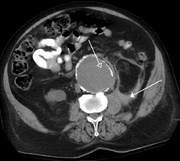
A CT scan image showing a ruptured abdominal aortic aneurysm
About
Medical imaging is the technique and process used to create images of the human body (or parts and function thereof) for clinical purposes (medical procedures seeking to reveal, diagnose, or examine disease) or medical science (including the study of normal anatomy and physiology). Although imaging of removed organs and tissues can be performed for medical reasons, such procedures are not usually referred to as medical imaging, but rather are a part of pathology.
Contents
As a discipline and in its widest sense, it is part of biological imaging and incorporates Radiology, Magnetic Resonance Imaging, Nuclear medicine, medical Ultrasonography or Ultrasound, Endoscopy, Elastography, Tactile Imaging, Thermography and medical photography.
As a field of scientific investigation, medical imaging constitutes a sub-discipline of biomedical engineering, medical physics or medicine depending on the context: Research and development in the area of instrumentation, image acquisition (e.g. radiography), modeling and quantification are usually the preserve of biomedical engineering, medical physics, and computer science; Research into the application and interpretation of medical images is usually the preserve of radiology and the medical sub-discipline relevant to medical condition or area of medical science (neuroscience, cardiology, psychiatry, psychology, etc.) under investigation. Many of the techniques developed for medical imaging also have scientific and industrial applications.
Medical imaging is often perceived to designate the set of techniques that noninvasively produce images of the internal aspect of the body. In this restricted sense, medical imaging can be seen as the solution of mathematical inverse problems. This means that cause (the properties of living tissue) is inferred from effect (the observed signal). In the case of ultrasonography the probe consists of ultrasonic pressure waves and echoes inside the tissue show the internal structure. In the case of projection radiography, the probe is X-ray radiation which is absorbed at different rates in different tissue types such as bone, muscle and fat.
The term noninvasive is a term based on the fact that following medical imaging modalities do not penetrate the skin physically. But on the electromagnetic and radiation level, they are quite invasive. From the high energy photons in X-Ray Computed Tomography, to the 2+ Tesla coils of an MRI device, these modalities alter the physical and chemical environment of the body in order to obtain data.
References
Links
- 21CFR 1020.30--Diagnostic x-ray systems and their major components. [Revised as of April 1, 2013]
Further reading
- Wikibooks: Basic Physics of Nuclear Medicine/X-Ray CT in Nuclear Medicine
- Wikibooks: Basic Physics of Nuclear Medicine/Dual-Energy Absorptiometry
- Wikibooks: Basic Physics of Nuclear Medicine/Computers in Nuclear Medicine
- Wikibooks: Basic Physics of Nuclear Medicine/MRI & Nuclear Medicine
- Wikibooks: Basic Physics of Nuclear Medicine/PACS and Advanced Image Processing
- Wikibooks:Basic Physics of Nuclear Medicine/Units of Radiation Measurement